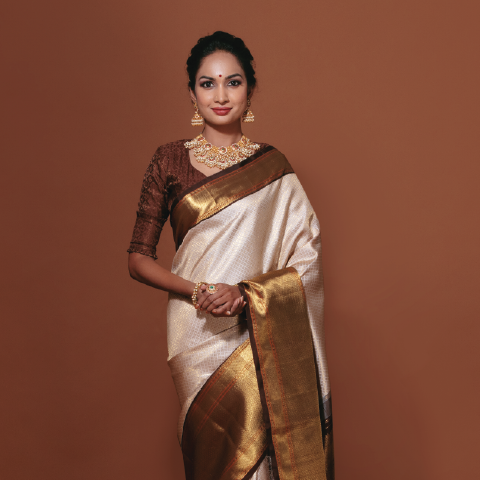"Six yards of elegance, charm and grace" can be the simplest description of a saree. Ever wondered how long this garment has been a part of our lives? Read along to know…
Saree, also known as sari is a traditional attire of Indian women. The name Sari originated from the Sanskrit word ‘Saadi’ which means ‘a strip of cloth’. In sanskrit literature, it is mentioned as Sattika and as Jatakas in buddhist literature.

The journey of sarees began alongside the Indus valley civilization around 2800 BC and we still use the dyes used then namely Indigo, lac, turmeric etc.
A saree is a long piece of cloth in a variety of fabric with many different prints, patterns and colours that is worn around the entire body in a particular way. The length of the saree varies from 6 yards to 9 yards depending on various factors like age, occasion and climate. Sarees are accompanied by parkars/pavada in the bottom and a choli /ravikai/blouse in the top. A saree has been such an integral part of our culture that even today it is a must have in our wardrobe. Saree as such has undergone various changes in terms of production, weaving, type of prints and the way it is worn. We are in an era where stitched readymade sarees are available and yet draping a saree in the traditional way and mastering it is still revered as a skill.
The journey of sarees began alongside the Indus valley civilization around 2800 BC and we still use the dyes used then namely Indigo, lac, turmeric etc. Earliest records of cotton and silk are also found 5000 years ago indicating how well established this culture was. Literary works like Kadambari by Banabhatta and Silapathikaram by Ilangoadigal talk in detail about sarees. This is just an example, there are many literary works that stand as a proof for the wide use of saree by women from time immemorial. Like the saree, the choli or ravikai or blouse has also undergone a variety of changes from the way it is worn and tied. The Dharmasastra and the Natya shastra are said to have had difference of opinion about how the saree is draped in terms of exposing the midriff.

With such rich heritage, the saree has a lot to be revered for its travel through so many centuries withstanding cultural, economic and technical transformations. For an Indian woman, saree is not just another attire but an extension of her personality. Next time you wear a saree, enlive the rich lineage that unfolds as you pleat it. Remember, you are wearing a piece of garment that has lived through centuries!






